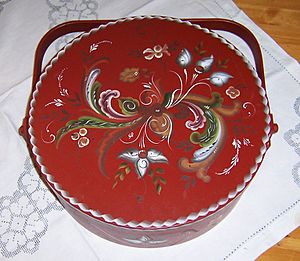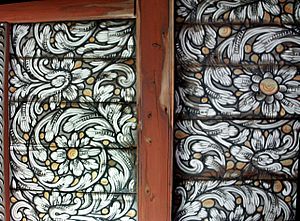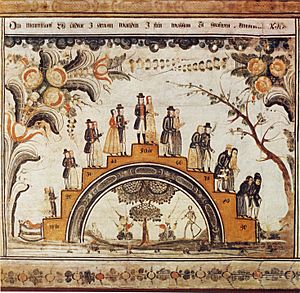Rose-painting facts for kids
Rose-painting (also called rosemaling in Norwegian and rosmålning in Swedish) is a beautiful type of traditional folk art. It started in Scandinavia in the 1700s and was very popular until the mid-1800s, especially in Norway. In Sweden, it later got new names like dalmålning and kurbitsmålning.
Rose-painting was first used to decorate church walls and ceilings. Later, people started painting everyday wooden items. These included bowls, chairs, cupboards, and chests. The art uses fancy designs with imaginary flowers, swirling patterns, fine lines, and sometimes geometric shapes. This gives rose-painting its unique look. Some paintings even show landscapes or buildings. Artists also used special techniques like glazing, spattering, and marbleizing. Different regions developed their own unique styles of rose-painting.
Contents
What Does "Rose-Painting" Mean?
The name "rose-painting" comes from a Norwegian word, ros, which means "decoration" or "embellishment." It can also refer to the rose flower itself. However, the flowers in these paintings are often so stylized that they don't look like any specific flower. Sometimes, there are no flowers at all!
In Sweden, this style was first called rosmålning. Later, in the 20th century, people started using dalamålning or dalmålning. This name comes from Dalarna, a region in Sweden where the style was very popular. Another Swedish name is kurbitsmålning. Kurbits comes from a Latin word for a long-bodied gourd (a type of squash). A poet named Erik Axel Karlfeldt helped make this term popular in the 1920s.
Rose-Painting in Norway: A Journey Through Time
Rose-painting in Norway began in the early 1700s. It started in the rural areas of eastern Norway, especially in valleys like Telemark, Valdres, and Hallingdal. This art style grew when fancy Baroque and Rococo art from the upper classes reached the countryside. Before this time, there's no record of rose-painting, showing a change in Norwegian folk traditions.
As the art grew, different regional styles appeared. Some were slightly different, while others were very unique. By the mid-1700s, more people became painters. This led to many new and exciting rose-painting styles. Artists even started signing their work. This helps historians today see how many pieces certain artists made and even find families of painters. However, rose-painting became less popular by the mid-1800s.
How Norwegian Rose-Painting Looks
Norwegian rose-painting uses "C" and "S" shaped brushstrokes. These create swirling lines, floral designs, and both soft and bright colors. Sometimes, artists also added script letters, scenes, animals, or even people. For example, when Norway was ruled by the Danes, some artists painted the Danish King and Queen.
Many rose-painters came from poorer families in the countryside. They would travel from one area to another. They painted churches, homes, and furniture for money or just for a place to stay and food. This helped spread rose-painting across Norway. Away from city influences, these artists tried new ideas. Soon, strong regional styles developed. Today, the three main styles are Telemark, Hallingdal, and Rogaland. They are named after the regions where they started.
Rose-Painting and Wood Carving
Rose-painting is like the painted version of acanthus wood carving. The swirling "C" and "S" shapes in rose-painting came from acanthus carvings. These carvings were found in Baroque and Rococo art, and in rural churches and homes. While city carvings were often covered in gold, rural artists used bright paints. This is because they didn't have easy access to gold leaf. These bright colors were also popular in traditional Norwegian rural clothing, called bunad.
Rose-Painting During World War II
During the German occupation of Norway (1940–1945), Norwegians found a clever way to show their loyalty. It was dangerous to display the Norwegian flag or their king's symbol. But they discovered they could hide the "H" and "7" (for their exiled King Haakon VII) inside a rose-painting design. The German soldiers just saw a colorful peasant design. Christmas cards with this hidden symbol were very popular and many still exist today.
Rose-Painting Today in Norway
Today, rose-painting is becoming popular in new ways. In the 1700s, you could only see it in homes and churches. Now, you can find rose-painting on bowls, vases, plates, jewelry boxes, and many furniture items. This helps the art stay popular. You can see it in museums like the Norwegian Folk Museum. Many shops in Norwegian tourist cities sell unique, hand-painted rose-painted items.
These items are often expensive because they are made the traditional way, by hand. Each piece is carefully made and unique. The process takes time. For example, wooden items first get a special oil-based paint or wood stain. These colors are often deep blue, red, dusty pink, white, black, or brown. The price depends on how detailed and large the design is. A large bread tray, for instance, can sell for as much as $240.
Modern rose-paintings still look a lot like older ones. Since "rosemaling" just means "decorative painting" in Norway, designs aren't always flowers. They can show farm landscapes, historical events, or scenes from rural life. Some even show scenes from children's stories or fairy tales, like "Little Red Riding Hood." New styles have also appeared beyond the famous Telemark, Hallingdal, and Rogaland styles.
Rose-painting is most common in southern Norway today, especially in Telemark and Hallingdal. However, styles still vary from city to city. This is why they are named after regions. For example, Telemark style is very detailed and ornate, influenced by 18th-century French art. Hallingdal artists often prefer to sell their work privately.
Some rose-painted items are now made in factories and sold for less money. This started when homes became more modern and people wanted more decorations. However, buying hand-crafted items from artists helps keep the traditional Norwegian culture of rose-painting alive. Norwegians see rose-painting as a way to share their identity and culture. Museums like the Nordic Museum and Chicago Public Library still display many rose-paintings.
Rose-Painting in Sweden: The Kurbits Style
In Sweden, rose-painting uses light brush strokes and shows gourds, leaves, and flowers. It was used to decorate furniture and wall hangings. This style was very popular in the late 1700s. Wealthier families often had more rose-paintings because they could afford more decorations. Even after factories started making things, rose-painting stayed popular. It was seen as a big part of Sweden's folk culture.
The tradition of painted wall hangings was fully developed around 1820. Traveling painters, mostly from Dalarna, created these works. They learned from each other and copied designs. Some designs were copied over 140 times! Artists also used stamps for small details. Painters from the Rättvik school often added spontaneous leaves and flowers, making their pieces less symmetrical. Many paintings also had a zig-zag pattern at the bottom called ullvibården.
The scenes often came from Bible stories. People and buildings were painted in the styles of that time. The gourds in kurbits art refer to a Bible story about Jonah sitting under a gourd. The gourd symbolizes growth and life. Common themes in kurbits art include the wedding at Cana, Jonah preaching, and stories about Jesus.
The kurbits style is found in Dalarna and southern Norrland. Today, kurbits can refer to painting furniture, tapestries, Dala horses, or Swedish folk painting in general. On a Dala horse, a gourd shape is used to show the saddle. Famous kurbits artists include Winter Carl Hansson and Back Olof Andersson. The kurbits style was even used in the logo for Stockholm-Åre's bid for the 2026 Winter Olympics.
Rose-Painting in America: A New Home
Norwegian immigrants brought rose-painting to the United States. Immigration from Norway to America began in the 1830s. Rose-painting was more than just decoration for these immigrants. It was a way for them to keep their heritage alive. They maintained their strong Norwegian identity in their homes and at ethnic festivals. Rose-paintings were often displayed at these events. Many immigrants traveling to the Midwest also painted in churches to earn money. This helped spread different rose-painting styles.
The art form became popular again in the 1900s. Norwegian-Americans became interested in the rose-painted items their ancestors owned. Artists like Per Lysne, who was born in Norway and moved to Wisconsin, helped this revival. Lysne is often called the "father of rosemaling in the U.S." The art's popularity peaked from the 1960s to the 1980s. In the late 1960s, the Vesterheim Norwegian-American Museum in Decorah, Iowa started showing rose-painting. The museum also brought Norwegian rose-painters to the U.S. to teach classes. The style became very popular, even among non-Norwegians. Today, you can find classes across the country, especially where Norwegians settled.
The Swedish town of Lindsborg, Kansas is known for its Dala horses and other celebrations of Swedish heritage.
Today, rose-painting is still most common in the Upper Midwest. This is because many Norwegians moved there between the 1840s and 1910s. The Norwegian-American Museum still offers workshops. You can also learn rose-painting through books, classes, and heritage centers. This helps pass on these skills to future generations.
Some Norwegian-American rose-painting styles are now called "Americanized." They are seen as part of Upper Midwest communities, not just Norwegian heritage. These "Americanized" styles, which started between 1930 and 1960, often use brighter colors and special decorations. Examples include the American Rogaland style in Dane County, Wisconsin, and the American Telemark style in Milan, Minnesota.
Different Styles of Rose-Painting
There are many different styles of rose-painting. Each style is usually named after the region where it is most used.
- Telemark Style: This style is very popular in Norway. It often has a central root or swirl with flowers and branches flowing out from it. There are two types within Telemark style:
- Transparent Telemark: This uses light brush strokes, almost like you can see through them.
- American Telemark: This mixes the regular Telemark style with the transparent Telemark style.
- Hallingdal Style: This style is different from Telemark. The paint is often bolder and less see-through. It also has more symmetry and patterns.
- Rogaland Style: This style uses more floral images than lines or swirls. It often has a dark background with a central flower surrounded by leaves and other decorations.
- Valdres Style: This style is known for having some of the most realistic-looking floral designs.
Images for kids
-
A wardrobe from Tolvmansgården, birthplace of Erik Axel Karlfeldt
See also
 In Spanish: Rosemaling para niños
In Spanish: Rosemaling para niños













